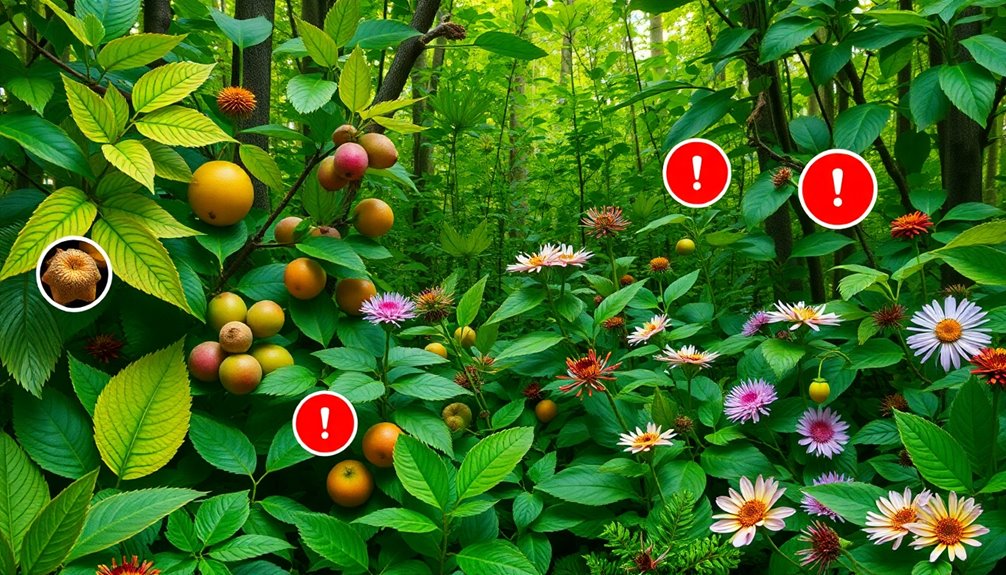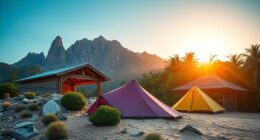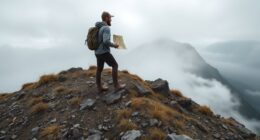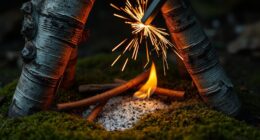When you step into the world of wild foraging, understanding safety tips for identifying edible plants is crucial. You can't just rely on a single guide; using multiple resources and consulting seasoned foragers can help you avoid dangerous mistakes. Be mindful of poisonous lookalikes and the importance of odor in plant identification. While the thrill of foraging can be enticing, knowing how to approach it safely is essential. So, what are the specific guidelines and best practices that can ensure a positive experience in the wild?
Key Takeaways
- Always use multiple field guides for cross-referencing plant identification to ensure accuracy and avoid misidentification.
- Be aware of poisonous lookalikes and use the smell test to help identify potentially toxic plants.
- Perform the universal edibility test only on confidently identified plants and cook them to ensure safety.
- Check local laws and regulations regarding foraging, including any restrictions on state and privately managed lands.
- Join local foraging groups or workshops to gain hands-on experience and knowledge from seasoned foragers.
Introduction

Foraging for wild edible plants can be an exciting and rewarding experience, but it's essential to approach it with care. Proper identification is your first line of defense against misidentification, which can lead to severe illness or even death. You need to know exactly what you're eating, rather than just what to avoid.
Familiarizing yourself with plant parts, growing seasons, and preferred habitats will help you make informed choices. Always use multiple field guides and resources for triple-confirmation of plant identity. In addition, engaging with community workshops can provide valuable hands-on experience and guidance from experts. Many wild edibles are available in North American forests, making foraging a diverse and sustainable food source.
Avoid common mistakes like eating a plant unless you're 100% sure of its identity. Just because animals eat it doesn't mean it's safe for you. Stay away from plants with strong odors or those growing in groups of three, which could indicate poison ivy. Don't force a plant to match a description; if it doesn't fit, leave it alone.
Learning botanical terms is crucial to grasp the details that matter.
Legal Framework

Understanding the legal framework surrounding wild edible plant foraging is vital for a safe and responsible experience. Before you head out, check the laws and regulations in your area. Different locations will have varying rules about where it's legal to gather wild plants and mushrooms.
Familiarize yourself with the regulations on state and federally managed lands, and make sure you obtain permission if you're foraging on private property. Always ensure the area is publicly accessible and not private without consent. Additionally, be aware that foraging baskets can be essential tools for carrying your harvest efficiently.
Look for signs or consult online resources provided by state parks or local authorities regarding foraging regulations. Avoid foraging near busy roads, city parks, or industrial areas to minimize exposure to pollutants. Opt for lightly traveled or untouched areas for clean and safe harvests. Additionally, focus on learning specific local edible species to enhance your foraging experience. Incorporating knowledge of ethical foraging principles will further enrich your understanding of sustainable practices.
It's crucial to respect land use and permissions. Always ask landowners and land managers before foraging, and be mindful of conservation areas where foraging might be prohibited.
Lastly, avoid trespassing by knowing property boundaries and respecting public right-of-way areas. Following these guidelines will help you enjoy foraging while ensuring you're acting within the law.
Main Guidelines

When you're out in the wild looking for edible plants, following some key guidelines can enhance both your safety and enjoyment.
Focus on leaf shape and arrangement, as well as reproductive parts like flowers and fruits, which are crucial for identification. Don't forget to observe the stalk and trunk for any distinctive traits. Engaging in outdoor activity while foraging can also enhance your observational skills and deepen your connection to the environment.
Be aware of poisonous lookalikes; for example, hemlock can mimic Italian parsley. Use your sense of smell to help identify plants; wild onions should smell distinctly onion-like.
If you're uncertain, perform the universal edibility test, but only consume plants you can confidently identify. Start with familiar plants, like blackberries and raspberries, to build your knowledge.
Lastly, remember that some plants require cooking to be safe, while others may have toxic parts. Always refer to regional guides to ensure you're making safe choices in the wild.
Best Practices

Building on the main guidelines for identifying edible plants, adopting best practices will enhance your foraging experience and ensure safety. Start by using multiple field guides like *Newcomb's Wildflower Guide* and *Peterson's Field Guide to Edible Wild Plants* for cross-referencing.
Observe plants throughout the seasons to recognize all phases of growth, and consider growing your own plants from seed to master their identification. Additionally, foraging wild plants can lead to higher nutritional content, benefiting your overall health. Foraging also promotes a connection with nature, which is essential for fostering a deeper appreciation of the environment.
Always obtain permission to forage in an area, and check for pollution signs to avoid contaminated plants. Remember to harvest only what you need, preserving the local ecosystem.
Be cautious about foraging from roadside ditches, as these areas may be treated with harmful chemicals.
Know which parts of each plant are edible and when they're safe to eat. Keep a journal to document your observations about edible parts and their seasonal availability.
If you're unsure about a plant's safety, employ the universal edibility test, starting with a smell test.
Common Mistakes to Avoid

Many common mistakes can undermine your foraging efforts and put your health at risk. One major error is misidentifying plants. Relying on just one field guide or a single characteristic can lead to dangerous mistakes, especially with look-alikes like hemlock and celery. Always consult multiple sources and learn the botanical terms to enhance your identification skills. Additionally, understanding tree relationships can significantly improve your foraging success, particularly when searching for mushroom species. It's also essential to recognize that some plants can resemble each other, leading to heat pump failures in identification. Moreover, familiarizing yourself with non-toxic houseplants can help you differentiate between safe and harmful species. Additionally, staying informed about personal debt forgiveness bills can help you manage the costs associated with foraging supplies.
Another mistake is ignoring environmental contaminants. Collecting plants near roads or industrial sites exposes you to pollutants, while plants growing in contaminated areas can harbor toxins. Always wash your finds thoroughly, especially those from damp or polluted locations. Additionally, always harvest only healthy specimens to avoid plants affected by pests or diseases. Avoid consuming plants with strong, unpleasant odors, as this can indicate potential toxicity.
Inadequate testing and preparation can also pose risks. If you're unsure about a plant's safety, perform the universal edibility test. Some plants need cooking to be safe, and it's crucial to avoid eating parts that aren't edible. Watch for allergic reactions like nausea or burning sensations. Staying updated on the latest foraging techniques can also improve your confidence and safety.
Lastly, don't forage without proper knowledge. Many plants can be harmful, and just because animals eat them doesn't mean they're safe for you. Always supervise children when foraging, and avoid unfamiliar areas without guidance. Caution is key to safe foraging.
Special Considerations

Special considerations are essential for successful and safe foraging. First, be mindful of the environment. Avoid areas near busy roads, railway lines, and industrial plants where heavy metals and pollutants may contaminate plants. Steer clear of locations treated with pesticides or herbicides, like field edges and farms. Remember that urban areas can also harbor contaminated wild edibles.
Next, familiarize yourself with the typical habitats and seasonal growth stages of the plants you're targeting. This knowledge helps prevent misidentification and ensures you recognize which parts are safe to eat at various times of the year. Always observe multiple specimens, as environmental conditions can alter their appearance.
It's crucial to be aware of poisonous lookalikes. Learn the distinctive characteristics of both edible and toxic plants, including their smell and texture. Use Latin names to avoid confusion with common names. Always cross-reference your findings using multiple field guides and consult experienced foragers when in doubt. Additionally, consider joining local foraging groups that offer workshops and resources to enhance your skills and knowledge about wild edibles in your area.
If unsure, take photos or samples for further research. By prioritizing these special considerations, you'll enhance your foraging safety and enjoyment.
Resources and References

Consider seeking guidance from seasoned foragers or joining foraging clubs to gain hands-on experience.
Workshops and classes on wild edible identification can further enhance your skills.
Don't forget to utilize online databases and academic studies to stay updated on the latest research.
Lastly, while online plant identification tools and apps can be helpful, always cross-reference with physical guides to ensure you're making safe choices.
Conclusion
In conclusion, foraging for wild edible plants can be a rewarding adventure, but safety should always be your top priority. By following legal guidelines, properly identifying plants, and practicing sustainable harvesting, you can enjoy nature's bounty without the risks. Remember to consult multiple resources, avoid poisonous lookalikes, and be mindful of environmental conditions. With these tips in mind, you're well on your way to foraging confidently and responsibly. Happy foraging!










